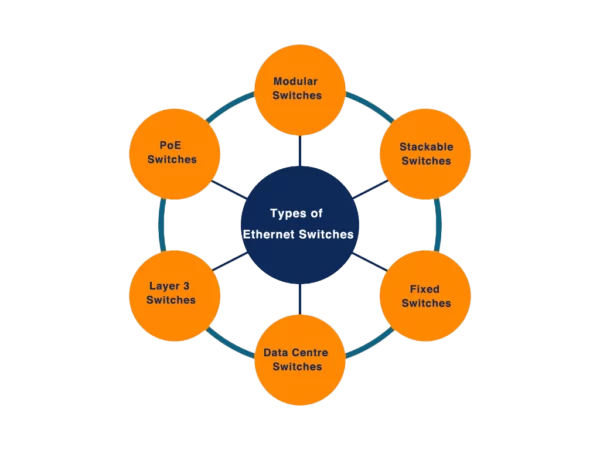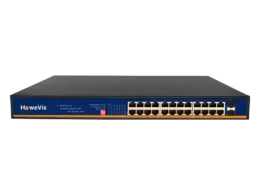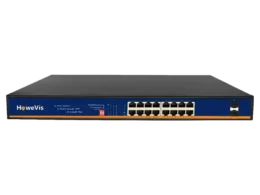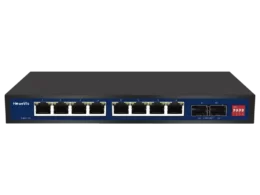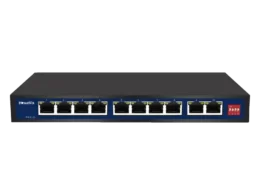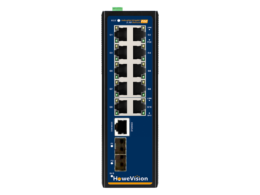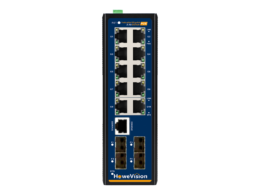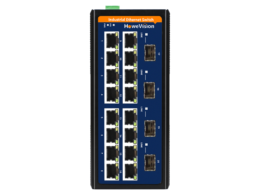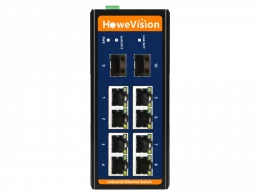Network switch works as the backbone of any computer networking system. Besides, it serves as the primary building block of LAN.
Nowadays, we get to see many switches. We see them in software modules that include virtualization technology. Yet, regular hardware switches that have many Ethernet ports are still necessary.
Be it a small business, corporate, or even home network, we can’t deny the role of Ethernet switches. But are all Ethernet switches PoE?
Of course, no. Not all Ethernet switches are PoE. PoE switches can transfer both power and data.
But, some devices can transfer only either power or data. So in this article, I will share different types of switches.
What Is an Ethernet Switch?
An Ethernet switch is a device that helps connect different wired devices. It includes devices like servers, computers, laptops, and even printers, to LAN. These switches have developed after their first introduction in 1990.
It can have more than one port to offer more agile connectivity and smooth access over many devices at once. In short, this switch forms networks and employs different ports to communicate among devices connected to the LAN.
But one vital thing I must tell you is that these switches differ from regular routers. That’s because many users have confusion between routers and switches. Of course, the router can help you connect networks. But it uses only a single WAN or LAN port.
Likewise, hubs are pretty similar to these switches when using ports. Yet, hubs and Ethernet switches are two different terms.
In hubs, the bandwidth is equally shared between different ports. Ethernet switches help us dedicate more or less bandwidth to particular ports. Moreover, you can do so without discrediting network performance. Thus, you can expect reliable performance from switches when many devices are active on the network.
You will notice the combination of hubs, routers, and switches in many corporate networks. But for small-scale and home use, you can consider using Ethernet switches.
I hope now you understand the meaning of Ethernet switches. These switches come in many different models. Of course, I will explain each type in the later section. But, before that, let’s understand what does PoE means.
What Does PoE Mean?
Power over Ethernet or PoE is a substantial evolution in technology. It is a protocol that helps us transfer both power and data together.
Thus, it reduces the installation and maintenance costs to a great extent. Besides, it also frees up so much space by taking out the role of separate wires from the network.
In PoE-enabled devices, an Ethernet cable carries both data and electrical current. You can check the list of devices that use PoE.
7 Types of Network Ethernet Switches
In this section, we will check different types of network Ethernet switches.
Fixed Switches
These switches are the most common ones available in the market. Here you get a definite number of Ethernet ports, like 8-ports, 16-ports, 24-ports, etc.
Thus, you can use fixed switches in any network type. It can be a small home network or an extensive corporate network setup.
If you want to combine more fixed switches, you can use a network cable. For this, you can use a fiber-optic or Cat6 Ethernet cable and form a trunk port between two static switches.
Modular Switches
Modular switches are pretty expensive. That’s why they are more suitable in large networks only.
These switches are expandable. You can expand them by combining more modules on the chassis. It gives you extra ports and superior performance.
In most cases, modular switches also provide you with Layer 3 functionality. Thus, you can use them as routers in your network.
Now, let’s talk about the most crucial part. These switches usually consist of separate power supplies. Thus, we cannot count this Ethernet switch in the category of PoE.
Stackable Switches
These switches are a combination of modular and fixed switches. But, of course, not all companies can afford to get modular switch models. Thus, they can invest in some fixed switch models.
We can stack fixed switch models with other switches to create a stackable switch unit.
The connected switches can communicate with each other. Besides, they can work as a single unit.
Thus, stackable switches give you a more affordable option. You can get them if you don’t want an expensive modular type.
PoE Switches
All the switches discussed so far provide ports to connect hosts and the network.
Yet, some switches come with ports that offer network connectivity and power to hosts.
Yes, we are talking about Power over Ethernet or PoE switches. These switches are beneficial to power up WiFi routers or IP phones. That’s because such remote devices may not always have a power source.
So, get a PoE switch if you want to manage end-point devices that are far from the main power supply. This switch will connect your devices to the network and power them up.
PoE switches are available in many different options. So, you can get this switch according to the number of ports you want.
You can opt for an industrial 14-ports PoE switch if you’re going to connect many devices. Besides, if you’re going to create an extensive corporate network, go for an industrial 24-ports PoE switch.
Switches with Optical Fiber Ports
Switches with optical fiber ports are unique. They consist of ports, including fiber optic ports and RJ45 ports.
In these switches, the RJ45 port is the most crucial interface. It connects to a standard Ethernet cable, Cat5, Cat6, or Cat7.
Most Ethernet cables come with a limit of 100-meter. But if you want connectivity over longer distances beyond this limit, you can use these switches with fiber optic cable.
Layer 3 Switches
As we know, most switches refer to the OSI model’s Layer 2. They forward Ethernet frames fast, from one port to another. Thus, they work at the Data Network layer.
But, some modern switches can further route IP packets more like a network router. We call them Layer-3 switches. These switches work at the OSI model’s Network Layer.
You can implement these switches at the core of extensive networks, especially star-topologies.
Data Centre Switches
The growth of data centers has been increasing over the last few years. Many companies unify their networks and other assets into massive data centers. It helps them achieve better management and administration.
Thus, data center switches have unique features. For example, it includes high-speed performance, security, massive port capacity, etc.
Final Thoughts!
That’s all about the different types of Ethernet switches. I hope now you understand that not all Ethernet switches are PoE.
As you can see, these switches are available in many options. Thus, an individual or organization can find a suitable solution for the network.
Many companies use wireless and wired technologies to manage their extensive networks.
They use Ethernet switches to build their wired infrastructure. But, among all Ethernet switches, they prefer to use PoE switches. That’s because this switch allows them to transfer both data and power to their network devices. It helps them reduce the installation cost.
